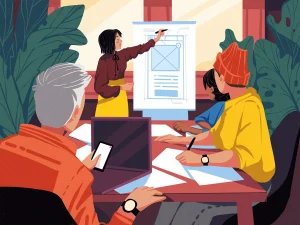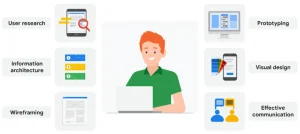The world of user experience (UX) is both very broad and very specific. It’s very broad in the sense that it applies to virtually every physical, digital, social, and omnichannel experience. It’s very specific in that it’s a relatively small yet crucial piece of the whole business and product development puzzle.

UX is important because it attempts to fulfill a user’s needs through positive experiences that encourage loyalty to a brand or product. A meaningful user experience translates to a successful product and overall business strategy.
As you start out on your path to becoming a UX designer, you’re probably curious about the actual work your new career might involve. In this reading, you can explore the different responsibilities that entry-level UX designers commonly take on during a project. You’ll also review the differences between generalist, specialist, and T-shaped UX designers.
Oftentimes, new UXers start out as generalists. This isn’t necessarily because it’s their choice but rather that’s what the market demands. UX is a challenging field, covering elements of design, research, technology, project management, strategy, and business, so companies tend to expect that practitioners have an experiential foundation that spans most or all of those specialties.
But first, a quick call out: You’ll probably notice a lot of new vocabulary and unfamiliar terms in this reading. Don’t worry! You’ll learn about each of these concepts in more depth throughout the certificate program. We’ll also provide a glossary of important terms and their definitions at the end of each week of content.
Responsibilities of an entry-level UX designer
As an entry-level UX designer, you’ll have a lot of exciting opportunities to gain experience. When you first start out, you’ll probably take on a lot of different roles and responsibilities.

User research:
User research is about understanding the people who use your product. Through research, you’ll learn about users’ backgrounds, demographics, motivations, pain points, emotions, and goals. Your research methods might include surveys, observations, and interviews. We’ll explore user research in much more detail in an upcoming course.
Information architecture:
Information architecture, or IA for short, involves deciding how your product is organized and structured. Think of IA as a skeleton that outlines how users interact with your product. Everything in your product should be organized in ways that make sense to the user and meets their expectations.
Wireframing:
A wireframe is a basic outline or sketch of a product or a screen, like an app or website. As the name suggests, wireframes look like they were created with wires. They’re mostly lines and shapes, with some text. Wireframes can be drawn by hand or created digitally using software. Wireframing helps you bring your design ideas to life, so other people on your team can provide input and feedback.
Prototyping:
A prototype is an early model of a product that demonstrates its functionality. Prototypes can be in physical or digital formats and can vary in complexity. Sometimes a prototype is made to demonstrate one specific feature of a product, like the transition between screens or the way the product physically looks and feels. You’ll make multiple prototypes for any given product throughout the design process.
Visual design:
Visual design focuses on how the product or technology looks. As a UX designer, you need to understand the foundations of visual design in order to communicate the connection between a product’s functionality and its appearance to users. You’ll learn some of the most important principles of visual design throughout this certificate program.
Effective communication:
Effective communication as a UX designer means connecting with your colleagues through emails, meetings, presentations, and design software. UX design is a very collaborative field, so being able to communicate both digitally and face-to-face with teammates is important. You need to be a good listener, be receptive to feedback, and share your ideas in a clear way.
How much do entry-level UX designers make?

Your future as a UX designer
There are so many different paths you can take within the field of UX design. After you land your first entry-level job and start working in the field, you’ll get a better idea of whether you want to be a UX design generalist or specialize in one specific type of design. There are plenty of benefits to being a generalist, specialist, or T-shaped designer, so it’s all about finding what works best for you!
Thanks for reading!



